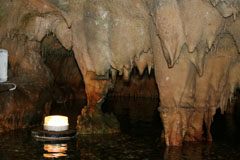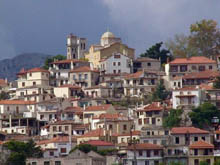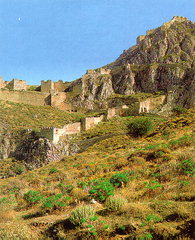|
|
|
|
|
Private
Tours: Three Days
TOUR
1: ANCIENT
CORINTH, CANAL, MYCENAE, NAFPLION, ANCIENT SPARTA & THE
BYZANTINE FORTIFIED CASTLE OF MYSTRAS, ANCIENT OLYMPIA
(Two overnight stays in Sparta and Olympia)
includes
a visit to: Ancient Corinth (where you
can see the Long Walls that begin at the summit of Acro-Corinth
and descend all the way to Lechaion, the artificial harbour
on the Corinthian Gulf, the Agora, the Dorian Temple of
Appollo [6th c. BC with 1st c. AD restorations], the museum
which contains mosaic floors, Mycenaean and Corinthian pottery,
terra cotta sphinxes, statues of two supernatural beings,
relief plaques, the Roman head of the goddess Tyche and
small objects of various kinds, and the Bima where St Paul
preached), The Canal (which is about 6
km long and connects the Aegean Sea with the Ionian Sea;
its width upon completion was 25 meters, and 8 meters deep),
Mycenae (where you will see the Cyclopean
Walls, the Grave Circle A with 6 royal tombs, courtiers’
houses, sanctuaries, the Grave Circle B with 14 royal tombs
and 12 tombs of private citizens, the Treasure of Atreus
also known as the beehive tomb of Agamemnon, and the Lions
Gate), Nafplion (where you will climb up
the 999 steps to the Venetian fortress of Palamidi crowning
the city, wander around the battlements of Acronafplia and
pop over to the fortified island, Bourtzi), Ancient
Sparta (some ruins remain of the ancient acropolis:
The Sanctuary of Artemis Orthia [6th c. BC], The Tomb of
Leonidas [5th c. BC], the Menelaion and the Olive Museum.
The museum with findings from the area is housed in a neoclassical
building in the centre of the town), The Byzantine
Fortified Castle of Mystras (some of the most important
monuments of the site of Mystra are: The Castle, The Cathedral
of Saint Demetrios, The Church of St. Theodore, The Church
of Aghia Sophia, The Monastery of Our Lady Perivleptos,
The Church of Our Lady Evagelistria, The Monastery of Our
Lady Pantanassa, The Palaces of The Mystra Despotes), and
finally Ancient Olympia where you will
see The Archaeological Site (the Prytaneion
[where ceremonies honoring the winners took place], the
Philippeion, next to it the Heraion [a Doric Temple dedicated
to Hera], the Pelopion [an altar dedicated to Pelops from
whom the Peloponnese is named], the Doric Temple of Zeus
[472 BC]), The Archaeological Museum (here
are displayed findings from the area, and among them there
are the stone head of Hera, Praxiteles’ marble statue of
Hermes [330 BC], the Victory by Paionios [421 BC], Miltiades’
helmet, the terra cotta group of Zeus carrying Ganymede,
and the sculptures from the pediments and metopes of the
Temple of Zeus, among the most important works of Classical
art. There are also pottery, terra cotta and bronze figurines,
and votive offerings from the sanctuary), and The Museum
of the Olympic Games (it contains mementos connected
with the history of the Games and a unique series of postage
stamps, designed by Papastephanos – Provatakis commemorating
the Games).
TOUR
2: ANCIENT CORINTH, CANAL, MYCENAE, NAFPLION, ANCIENT OLYMPIA,
DELPHI & THE MONASTERY OF OSIOUS LUCAS (OR, THE BATTLE
GROUND OF CHAERONIA) (Two
overnight stays in Olympia and Delphi)
includes
a visit to: Ancient Corinth (where you
can see the Long Walls that begin at the summit of AcroCorinth
and descend all the way to Lechaion, the artificial harbour
on the Corinthian Gulf, the Agora, the Dorian Temple of
Appollo [6th c. BC with 1st c. AD restorations], the museum
which contains mosaic floors, Mycenaean and Corinthian pottery,
terra cotta sphinxes, statues of two supernatural beings,
relief plaques, the Roman head of the goddess Tyche and
small objects of various kinds, and the Bima where St Paul
preached), The Canal (which is about 6
km long and connects the Aegean Sea with the Ionian Sea;
its width upon completion was 25 meters, and 8 meters deep),
Mycenae (where you will see the Cyclopean
Walls, the Grave Circle A with 6 royal tombs, courtiers’
houses, sanctuaries, the Grave Circle B with 14 royal tombs
and 12 tombs of private citizens, the Treasure of Atreus
also known as the beehive tomb of Agamemnon, and the Lions
Gate), Nafplion (where you will climb up
the 999 steps to the Venetian fortress of Palamidi crowning
the city, wander around the battlements of Acronafplia and
pop over to the fortified island, Bourtzi), Ancient
Olympia where you will see The Archaeological
Site (the Prytaneion [where ceremonies honoring
the winners took place], the Philippeion, next to it the
Heraion [a Doric Temple dedicated to Hera], the Pelopion
[an altar dedicated to Pelops from whom the Peloponnese
is named], the Doric Temple of Zeus [472 BC]), The Archaeological
Museum (here are displayed findings from the area,
and among them there are the stone head of Hera, Praxiteles’
marble statue of Hermes [330 BC], the Victory by Paionios
[421 BC], Miltiades’ helmet, the terra cotta group of Zeus
carrying Ganymede, and the sculptures from the pediments
and metopes of the Temple of Zeus, among the most important
works of Classical art. There are also pottery, terra cotta
and bronze figurines, and votive offerings from the sanctuary),
and The Museum of the Olympic Games (it
contains mementos connected with the history of the Games
and a unique series of postage stamps, designed by Papastephanos
– Provatakis commemorating the Games), and finally The Famous
Sanctuary of Delphi (which was the site
of the Delphic Oracle, the most important oracle in the
Classical Greek world), and The Monastery of Osious
Lucas (In the year 946 AC Osious Loukas first built
his cell, a small church in which to pray. He also made
a beautiful garden in which he grew his vegetables. He did
not, however, manage to finish it. He died in February 7,
953 AC at the age of 56. The monastery is famous for its
wall paintings. Those paintings have been cleaned and restored
recently and they exhibit special interest).
TOUR
3: ANCIENT CORINTH, CANAL, THEATER OF EPIDAURUS, MYCENAE,
NAFPLION, ANCIENT SPARTA & THE BYZANTINE FORTIFIED CASTLE
OF MYSTRAS, CAVES OF DIROS (Two overnight stays in
Nafplion and Sparta)
includes
a visit to: Ancient Corinth (where you
can see the Long Walls that begin at the summit of Acro-Corinth
and descend all the way to Lechaion, the artificial harbour
on the Corinthian Gulf, the Agora, the Dorian Temple of
Appollo [6th c. BC with 1st c. AD restorations], the museum
which contains mosaic floors, Mycenaean and Corinthian pottery,
terra cotta sphinxes, statues of two supernatural beings,
relief plaques, the Roman head of the goddess Tyche and
small objects of various kinds, and the Bima where St Paul
preached), The Canal (which is about 6
km long and connects the Aegean Sea with the Ionian Sea;
its width upon completion was 25 meters, and 8 meters deep),
The Theater of Epidaurus (which is marbeled
for its exceptional acoustics, which permit almost perfect
intelligibility of unamplified spoken word from the proscenium
or skene to all 15,000 spectators, regardless of their seating),
Mycenae (where you will see the Cyclopean
Walls, the Grave Circle A with 6 royal tombs, courtiers’
houses, sanctuaries, the Grave Circle B with 14 royal tombs
and 12 tombs of private citizens, the Treasure of Atreus
also known as the beehive tomb of Agamemnon, and the Lions
Gate), Nafplion (where you will climb up
the 999 steps to the Venetian fortress of Palamidi crowning
the city, wander around the battlements of Acronafplia and
pop over to the fortified island, Bourtzi), Ancient
Sparta (some ruins remain of the ancient acropolis:
The Sanctuary of Artemis Orthia [6th c. BC], The Tomb of
Leonidas [5th c. BC], the Olive Museum, and the Menelaion.
The museum with findings from the area is housed in a neoclassical
building in the centre of the town), The Byzantine
Fortified Castle of Mystras (some of the most important
monuments of the site of Mystra are: The Castle, The Cathedral
of Saint Demetrios, The Church of St. Theodore, The Church
of Aghia Sophia, The Monastery of Our Lady Perivleptos,
The Church of Our Lady Evagelistria, The Monastery of Our
Lady Pantanassa, The Palaces of The Mystra Despotes), and
finally The Caves of Diros (which are located
in Mani. They are part of an underground river, and the
5,000 meters that have been exposed are fascinating. From
the entrance, skillful, whristling gondoliers steer small
boats through narrow passageways, around beautiful formations
of stalagmites and stalactites, their colors created by
rain water penetrating the calcium carbonate in the rock.
The Caves have served as places of worship in Paleolithic
and Neolithic times, they are though by many to be connected
to the Underworld!).
TOUR
4: HIKING IN LOUSIOS GORGE, ANCIENT OLYMPIA, DELPHI, ARACHOVA
& THE MONASTERY OF OSIOUS LUCAS (OR,
THE BATTLE GROUND OF CHAERONIA)(Two overnight
stays in Olympia and Delphi)
includes
a visit to: Lousios Gorge (a five kilometer
gorge with several hiking trails, and a very good bridge
crossing Lousios river. You can walk from one village to
another folowing a dirt road through the mountains in beautiful
scenery that even has some small waterfalls. The Lousios
river is where Zeus used to bath himself, in the spectacular
densely vegetated gorge and in the river’s crystal clear
waters), Ancient Olympia where you will
see The Archaeological Site (the Prytaneion
[where ceremonies honoring the winners took place], the
Philippeion, next to it the Heraion [a Doric Temple dedicated
to Hera], the Pelopion [an altar dedicated to Pelops from
whom the Peloponnese is named], the Doric Temple of Zeus
[472 BC]), The Archaeological Museum (here
are displayed findings from the area, and among them there
are the stone head of Hera, Praxiteles’ marble statue of
Hermes [330 BC], the Victory by Paionios [421 BC], Miltiades’
helmet, the terra cotta group of Zeus carrying Ganymede,
and the sculptures from the pediments and metopes of the
Temple of Zeus, among the most important works of Classical
art. There are also pottery, terra cotta and bronze figurines,
and votive offerings from the sanctuary), and The Museum
of the Olympic Games (it contains mementos connected
with the history of the Games and a unique series of postage
stamps, designed by Papastephanos – Provatakis commemorating
the Games), The Famous Sanctuary of Delphi
(which was the site of the Delphic Oracle, the most important
oracle in the Classical Greek world), Arachova,
and finally The Monastery of Osious Lucas
(in the year 946 AC Osious Loukas first built his cell,
a small church in which to pray. He also made a beautiful
garden in which he grew his vegetables. He did not, however,
manage to finish it. He died in February 7, 953 AC at the
age of 56. The monastery is famous for its wall paintings.
Those paintings have been cleaned and restored recently
and they exhibit special interest).

|
|



